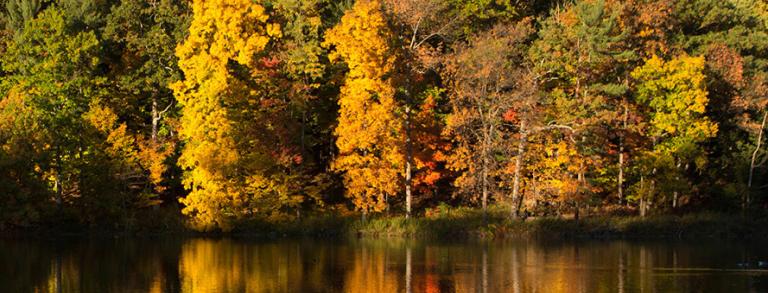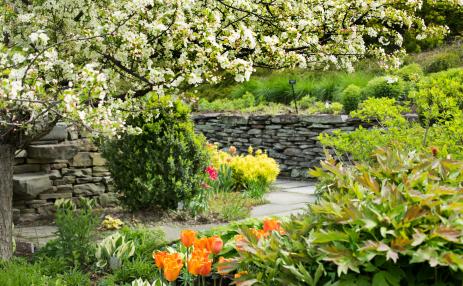Cornell botanic gardens, co-sponsor of the 2020 NARGS conference in Ithaca, New York, is excited to welcome NARGS members and rock garden enthusiasts from around the world. What follows is a glimpse into Cornell Botanic Gardens’ rich history, renowned collections, and stunning geology to prepare you for your trip to our region.
The natural beauty of the Cornell University campus and surrounding lands is cared for and enhanced by the botanic gardens. We welcome over 70,000 visitors a year to our cultivated gardens, arboretum, and natural areas. Together these comprise one-third of the Ithaca, New York, campus and, with off-campus natural areas, a total of 3,600 acres. Established in 1925 as the Cornell Arboretum, the gardens were later renamed Cornell Plantations and, in 2016, became Cornell Botanic Gardens.
The Cultivated Gardens
The 35-acre cultivated gardens surrounding the Nevin Welcome Center include specialty gardens of herbs, flowers, vegetables, perennials, ornamental grasses, groundcovers, and rhododendrons, among others.
In June of 1981, a rock garden was created in honor of Walter C. Heasley, Jr., a former Cornell University alumnus trustee. It features true alpine herbaceous perennials as well as dwarf and miniature perennials and conifers. The garden was originally designed to represent four alpine habitats: scree, moraine, rock outcropping, and meadow, with plants appropriate to each habitat. Interpretation focused on plant adaptations that allow alpines to flourish in the harsh, short growing season above the tree line. However, the garden proved too small to adequately represent these very different habitats, and the plants, particularly the meadow plants, were too large for the space. Plans to expand the garden and implement a more successful meadow were thwarted. Currently, the garden displays true alpines as well as plants of diminutive size that harmonize with and have cultural requirements similar to true alpines.
The Heasley Rock Garden is in a transition phase. While there is currently no funding to support the continued maintenance and development of the garden, a dedicated group of local NARGS volunteers’ energy and enthusiasm is driving a rejuvenation project to breathe new life into the space. This spring, thanks to the generosity of NARGS donors, we planted new acquisitions that are thriving in the hot sunny gravel of the western end, including Astragalus angustifolius and Hypericum olympicum, and dense, leafy gems that relish the cool, dry shade of chamaecyparis on the east end, such as Epimedium grandiflorum var. higoense ‘Bandit’ and Hosta ‘Bill Dress’s Blue.’ Our next phase of rejuvenation includes propagating from the NARGS seed exchange and collaborating with our Natural Areas staff to include regional native plants adapted to rocky limestone sites.
The Natural Areas
The most beloved natural areas on and around the Cornell campus are stewarded by the Cornell Botanic Gardens. Over 40 miles (64 km) of public trails wind through the glacially carved landscape, including around Beebe Lake and the Fall Creek and Cascadilla Creek Gorges. Cascadilla Creek drops 400 feet (122 m) from campus to downtown Ithaca, carving through bedrock — shale, siltstone and sandstone — and exposing sedimentary rocks that were deposited 400 million years ago. The Mundy Wildflower Garden along Fall Creek features over 640 species of native plants and a recently restored stream bank planted with wild-collected seed from regional references sites.
In addition to maintaining these treasures for the enjoyment of the public, the Botanic Gardens protects rare and endangered native plants and collaborates with scientists in many areas of research and conservancy. For example, staff have collected and preserved nearly 7,000 seeds from 300 individual plants across four populations to help safeguard one of our region’s rarest species: the American globeflower (Trollius laxus subsp. laxus). We are also protecting more than 2,000 hemlocks from hemlock woolly adelgid and are collaborating with the New York State Hemlock Initiative to study the effectiveness of using biocontrol agents.
The Arboretum
The 100-acre F. R. Newman Arboretum is home to more than 1,000 woody plant taxa, including collections of nut trees, crabapples, maples, oaks, urban trees, and shrubs. Its rolling hills and valleys were carved by Fall Creek following the retreat of the last glaciers more than 10,000 years ago. Today, the arboretum offers a pastoral setting and panoramic views, amidst a living museum of trees, shrubs, and woodland plants. A car loop, paved footpaths, and woodland trails offer visitors a variety of opportunities for exploration and stunning vistas. In the winter, it is a popular destination for cross-country skiers.
Mission and Vision
The mission and vision are the foundation of the Botanic Gardens’ work now and going forward. They grew from the input received during the strategic planning process, as well as our deep commitment to conserving the natural world and the diverse cultures it supports.
Our mission is to inspire people – through cultivation, conservation, and education – to understand, appreciate, and nurture plants and the cultures they sustain. These three pillars are depicted in our logo as a weave to represent our vision: a world in which the interdependence of biological and cultural diversity is respected, sustained, and celebrated. They also serve to remind us of the interrelationships of our physical spaces: gardens, natural areas, and an arboretum. In its suggestion of a botanic flame, the logo symbolizes the energy of the people within our organization, our will to inspire, and our path to teach and honor nature’s best practices, past and present.
We look forward to sharing that vision with NARGS members who are coming from around the world for the national conference in 2020. We invite you to visit our gardens, arboretum, and natural areas to find inspiration and feed your passion.


